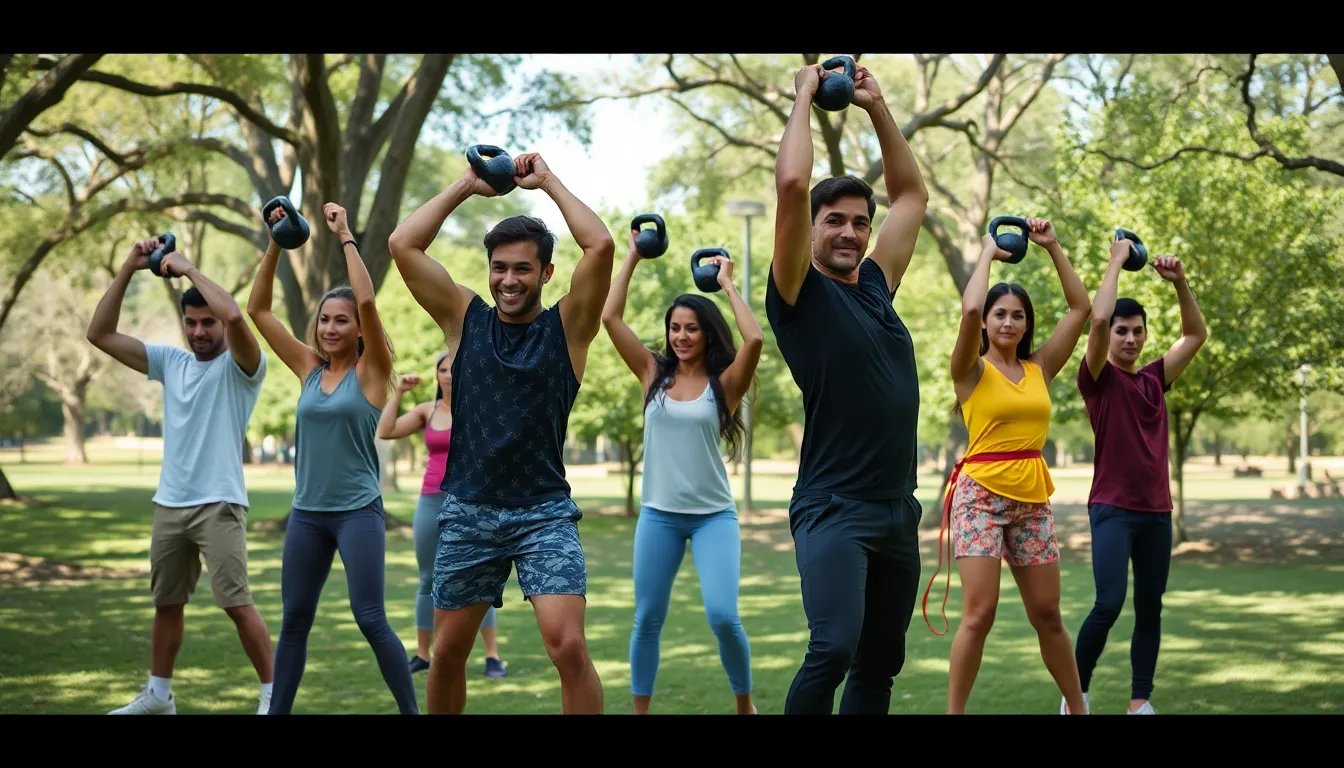In a world where everyday tasks can feel like a workout in themselves, why not train like you mean it? Functional fitness training programs are the secret sauce to not just surviving your daily grind but thriving in it. Imagine lifting groceries without pulling a muscle or chasing after your kids without gasping for breath. It’s not just about looking good; it’s about feeling like a superhero in your own life.
Table of Contents
ToggleWhat Is a Functional Fitness Training Program?
A functional fitness training program emphasizes exercises that mimic real-life movements. Such programs focus on building strength, balance, endurance and flexibility necessary for everyday activities. Both strength and stability play crucial roles in these workouts, which often incorporate tools like kettlebells, medicine balls and resistance bands.
Participants engage in various activities to enhance their overall physical performance. Operations include squats, lunges, push-ups and core exercises. These movements improve essential skills such as lifting, bending and twisting, making daily tasks more manageable.
Many functional fitness programs use a combination of cardiovascular training and strength building. This approach not only targets muscle enhancement but also boosts stamina. As a result, individuals often experience increased energy levels throughout their daily routines.
Personalization is another key aspect of these training programs. Each program can adapt to accommodate different fitness levels and goals. Trainers often suggest modifications based on an individual’s specific needs, ensuring effective results and injury prevention.
Community often accompanies functional fitness classes, fostering motivation and support. Participants benefit from group dynamics, which can enhance accountability and enjoyment. Regular engagement in this type of training can lead to significant improvements in functionality and quality of life.
A functional fitness training program cultivates physical capabilities that enhance daily living. Each workout integrates movements that boost strength and flexibility, setting individuals up for success in their everyday activities.
Benefits of Functional Fitness Training

Functional fitness training programs provide significant advantages that translate to improved daily living. These workouts enhance physical capabilities, boosting overall well-being and confidence in everyday tasks.
Improved Strength and Endurance
Functional fitness training enhances strength and endurance. By focusing on exercises that mimic daily movements, individuals develop practical muscle strength. Everyday tasks become easier, whether lifting groceries or carrying a child. Increased endurance supports sustained energy levels throughout the day. Individuals often find they can perform activities longer without fatigue. Engaging with tools like kettlebells and resistance bands helps facilitate these gains. Customized programs target specific areas and include progressions, allowing individuals to improve steadily. Personal trainers often provide modifications to suit various fitness levels. This approach leads to long-lasting physical improvements that go beyond the gym.
Enhanced Flexibility and Balance
Functional fitness training significantly boosts flexibility and balance. Improved flexibility reduces the risk of injury during everyday movements. Stretching and mobility exercises incorporated in the training routine enhance range of motion. Balanced strength leads to better stability, crucial for preventing falls, especially in older adults. Individuals practicing functional movements develop better coordination, linking various muscle groups together. Engaging in activities such as lunges and squats fosters greater body awareness. As core stability improves, it directly translates to enhanced posture. Individuals often notice the ability to perform movements fluidly, which improves quality of life. This holistic approach to fitness ensures participants maintain mobility as they age, supporting functional independence.
Key Components of a Functional Fitness Training Program
Functional fitness training programs encompass essential components that contribute to overall effectiveness. Focused on practical movements, these components help individuals enhance their physical capabilities for daily activities.
Movement Patterns
Emphasizing natural movement patterns defines the core of functional fitness. Squatting, lunging, pushing, pulling and rotating mimic everyday tasks. Training these patterns develops strength, coordination and balance. Not only do they enhance performance in daily activities, but they also significantly reduce the likelihood of injury. Functional fitness programs integrate these movements to ensure participants cultivate a comprehensive fitness foundation that serves their daily needs.
Equipment Utilization
Utilizing versatile equipment contributes greatly to functional fitness training. Common tools include kettlebells, medicine balls and resistance bands. Each piece of equipment offers unique benefits, targeting various muscle groups effectively. Resistance bands enhance strength while promoting mobility, whereas kettlebells boost endurance and power. Incorporating a variety of equipment keeps workouts engaging and challenging, ensuring progress across different fitness levels. Trainers often adapt and modify exercises with these tools, reinforcing functionality and preventing injury during workouts.
How to Design Your Functional Fitness Training Program
Designing a functional fitness training program requires careful consideration of personal needs and capabilities. Focusing on practical exercises helps create a tailored plan that enhances everyday performance.
Assessing Your Fitness Level
Determining fitness level involves evaluating current strength, endurance, flexibility, and balance. Individual assessments can take various forms, including personal fitness tests or consultations with a certified trainer. Understanding limitations ensures exercises remain safe and effective. Analyzing past injuries or chronic conditions contributes to a more comprehensive understanding. Incorporating self-assessments can further guide individuals in selecting suitable activities and adapting workouts accordingly.
Setting Goals and Objectives
Establishing clear goals redirects efforts toward specific outcomes. Participants may aim to improve strength, enhance endurance, or increase flexibility. Short-term objectives could include mastering a particular exercise or achieving a specific number of repetitions. Long-term goals, on the other hand, can focus on overall fitness improvements or enhanced performance in daily tasks. Tracking progress provides motivation, reinforcing commitment to the program. Collaborating with a trainer for customized objectives can optimize results and maintain accountability throughout the journey.
Embracing a functional fitness training program can profoundly enhance daily life. By focusing on real-world movements and personalized goals, individuals can improve their strength, balance, and endurance. This type of training not only boosts physical capabilities but also fosters a supportive community that encourages accountability and enjoyment.
As participants engage in workouts tailored to their unique needs, they cultivate a solid foundation for functional independence. The benefits extend beyond the gym, empowering individuals to tackle everyday tasks with confidence and ease. Ultimately, functional fitness isn’t just about working out; it’s about enhancing quality of life and maintaining mobility as one ages.






